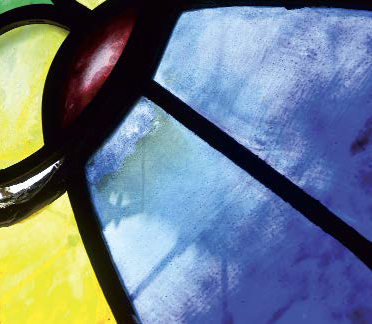
© Pere Virgili
Fragment of the stained glass window of the church of the Colònia Güell seen from the inside. Gaudí studied glass colouring methods and the orientation of the openings extensively in order to use the changes of sunlight in a creative way.
The phrase Gaudí used to compare oak trees – endowed with strength gained over many years – with reeds – which grow fast but are extremely fragile – aptly expresses the artist’s thinking and spirituality.
One of the most obvious yet fascinating gaps regarding Gaudí is the lack of a precise mapping of his imaginary world; his physical, intellectual, cultural, social and spiritual universe as it relates to his personality and his creativity. In The Hedgehog and the Fox, Isaiah Berlin said that interest towards an artist does not lie so much in the formal analysis of his work as in identifying how ideas, attitudes, conceptions, interests, ideals and value systems are assigned. This is, hence, the perspective that corresponds to Gaudí.
Gaudí’s revolutionary and creative power arises from a historically controversial triad: he was a great artist (i.e., highly personal); he was radical (completely free, on the sidelines of fashion and the avant-garde, despite setting precedents in some respects), and there was a fundamental spiritual component to his being.
“The wind destroys them and they are never spoken of again.” This phrase in which Gaudí compared the strength of oak trees – endowed with strength gained over many years – and reeds – which grow fast but are extremely fragile – aptly expresses the artist’s thought and spirituality, as if we were talking about a new Pascal. Gaudí was thus aware of the importance of his life and work. He was a hedgehog, according to the division of human characters between hedgehogs and foxes made by Berlin. That’s why they called him the Dante of architecture, another distinguished hedgehog.
Gaudí created bonds of identification between art, society, nature, beauty and God. In his words, he was not a mutilated man because he didn’t let any of his potential go to waste (body, intelligence and transcendental sense), and this inner strength brought out his creative genius and ideas about social justice, the working class, culture, nationalism, poverty, people, friends.
An analytical spirit capable of synthesis, the result of having observed and studied nature; technical mastery; prodigious use of his imagination and original creativity; spirituality as a driver – these are some Gaudí-esque features that are associated with today’s popular ideas: for Jaspers (1922), as earlier for Kandinsky (Concerning the spiritual in art, 1911), artistic practice is the ability to see the absolute in finite, material forms, from a perspective of authenticity. Hence Gaudí’s return to the origins to be original. Hence “the tree that I see from my workshop is my master”. Hence looking to nature to find forms and structures, materials and meaning. “Beauty is the splendour of Truth.” As such, nature – God’s work – is perfect and beautiful. Art is understood as personal collaboration with creation; everything is symbolic in the material sense. This is why Gaudí’s work requires contemplation, reflection and study. This is why he was devoted to the Sagrada Família: of 48 years of work, he dedicated 44 years to it, 12 exclusively. His “personal mission”, in the words of Josep M. Tarragona.
The fascination of the avant-garde
Mompou, a composer known for his metallic chord and “silent music”, said to those who were in vogue: “Maybe my music will be popular when yours is no longer in fashion.” A self-made avant-garde artist like Gaudí, with whom he shares parallels worthy of further examination.
There are some paradoxical relationships between some avant-garde artists and Gaudí. On the one hand, they find him innovative, brilliant and with practically boundless creative ability. On the other hand, they see him as being too tied to tradition, their craft, nature and religion. Le Courbusier admired Gaudí’s concept of space and material aesthetics. Miró paid tribute to his telluric creativity. Dalí, more caustic, recovered him for the history of art. Walter Gropius, Mies van der Rohe and Lloyd Wright all sensed his genius. In the social and spiritual sense of art, he was on a par with his contemporaries Kandinsky, Malevich and Van Gogh, and preceded American abstract expressionists, such as Rothko, in the search for the absolute.
Gaudí was ahead of his time when he theorised about the use and meaning of straight lines and curves, before Kandinsky and the Bauhaus. He was also advanced in the strict field of modernism: Casa Vicens was finished in 1888, while Casa Tassel by the Belgian Victor Horta, considered to be the first modernist house, was finished in 1893. Picasso maintained his silence or reacted aggressively, perhaps because Gaudí was the only artist he could not surpass, as it is rumoured he confessed to Miró, or because Gaudí’s trencadís (broken tile) technique preceded cubism…


